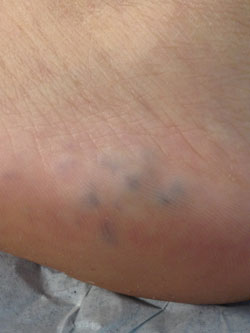Numerous blue papules on foot, shoulder of 12-year-old boy
A 12-year-old boy presents to your office with blue lesions on the shoulder and foot. His mother notes they first appeared on his shoulder when he was aged 7 years. As he has gotten older, more lesions have appeared. They are sometimes tender.

Carrie C. Coughlin

Marissa J. Perman
On physical exam, you note two firm, 4-mm to 6-mm blue papules on the posterior left shoulder and a cluster of eight similar blue papules on the right medial foot. Your patient has a 15-year-old sister who does not have similar findings. His mother has two similar papules but states her brother has several blue papules that look like her son’s. Your patient takes no medications and denies difficulty with excessive bleeding. He also denies fatigue (he plays point guard on his basketball team and has not missed a game) or difficulty breathing.
Can you spot the rash?
Diagnosis: Multiple glomangiomas (familial glomuvenous malformations)
Case Discussion
Glomangiomas (also known as glomuvenous malformations, glomangiomatosis) are derived from glomus cells, which are normally found in blood vessels at acral sites. Glomangiomas can appear as very small, solitary, randomly distributed papules or nodules, or in plaque or segmental forms. Glomangiomas present sporadically or may be inherited in an autosomal dominant manner (more common).
Familial glomangiomas are caused by a mutation in glomulin, which is on chromosome 1. The mutated gene is inherited with incomplete penetrance. A “second hit” occurs in affected areas to give rise to the vascular lesions. The phenotype among affected family members can be variable, as demonstrated in our case.


Figure 1: Blue papules on the shoulder. Figure 2: Clustered blue papules on the right medial foot.
Source: Perman MJ
Glomangiomas are differentiated from glomus tumors both clinically and histologically. Glomus tumors are more common and generally present as solitary lesions, although patients can have multiple tumors. They often occur around the nail and are very sensitive to temperature changes. Patients with multiple glomus tumors in the setting of neurofibromatosis type 1 have been reported, and researchers have shown loss of function of neurofibromin to be related to the formation of these tumors. Histologically, glomangiomas have more prominent vascular spaces that are lined by glomus cells, whereas glomus tumors show sheets of glomus cells.
The differential diagnosis includes multiple glomus tumors; blue rubber bleb nevus syndrome; venous malformations; multiple angiomas; and multiple hemangiomas.
Blue rubber bleb nevus syndrome (Bean syndrome) is characterized by multiple blue nodules on the skin and mucosa. They can be painful. Bleeding from lesions in the gastrointestinal tract can contribute to significant morbidity including chronic anemia. Superficial hemangiomas and angiomas tend to appear much redder than glomangiomas. Deep hemangiomas can be blue but have less epidermal change than glomangiomas. Glomangiomas can be somewhat compressible, but do not empty fully like venous malformations. Additionally, they are limited to the skin, whereas venous malformations can extend to muscle and bone and may involve mucosal surfaces as well.
Treatment of glomangiomas is optional. Surgical excision is prohibitive in patients with several lesions, and recurrence limits practicality. Sclerotherapy has been attempted but has risks of necrosis and scarring, in addition to pigmentary changes and induction of telangiectasias. Multiple lasers, including ablative and vascular lasers, have been used to destroy glomangiomas. Recent reports show good outcomes with the Nd:YAG 1064-nm laser.
Physicians should be aware of these benign blue tumors that often present in children to distinguish them from other vascular tumors and provide families with appropriate counseling.
Brems H. Cancer Res. 2009;69:7393-7401.
Brouillard P. Am J Hum Genet. 2002;70:866-874.
Hughes R. Arch Dermatol. 2011;147:255-256.
Shim TN. Clin Exp Dermatol. 2012;37:690-691.
Carrie C. Coughlin, MD, is a resident in the division of dermatology, Washington University School of Medicine, St. Louis. She can be reached at ccoughli@dom.wustl.edu.
Marissa J. Perman, MD, is an attending physician at The Children’s Hospital of Philadelphia.
Disclosure: Coughlin and Perman report no relevant financial disclosures.
